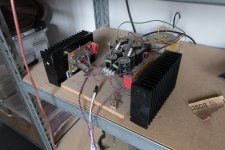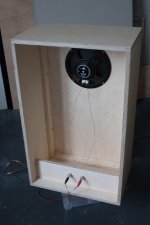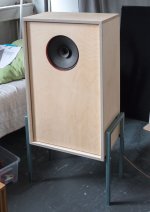There’s no problem leaving the ACA itself on 24/7. The SMPS may not last indefinitely, but it’s easy to replace as a separate component. I leave my Aleph J on constantly, and don’t worry because I’ve over specified all the components used in the power supply. The ACA is pretty robust from a component standpoint.
In a similar situation to yours I chose to build the M2X. The build thread is amazing and people are very helpful. Probably as much as the ACA thread. Summed to this, it is popular enough that a lot of problems and troubleshooting happened and are in the thread as well.
I would offer three points to consider (this roughly reflects my own thought process, so it's only one point of view):
1. Electrical Safety
The Pass amp designs beyond the ACA involve working with mains power. There's a raft of issues that accompanies that reality. Your local jurisdiction will probably take a view regarding wiring compliance to a national standard, along with the competence of the person doing that work. How your home electrics are protected for faults and earth leakage, is another thought process to work through.
In my case, I worked through these aspects, did my homework (as best I could) and decided I was up for it.
That said, the community here is very quick to offer up useful advice that helps people stay safe and keep out of trouble but in the end, if anything goes wrong, then you'll need to look in the mirror for the person you need to review any shortcomings with.
2. Input Signal - SE or Balanced
I wanted to feed my amp with a balanced signal. This cut down my choices to a BBA-3 or an Aleph J (as far as shop boards go). A single ended input signal opens up your choices significantly.
3. Component Matching
The various designs require matched transistors in places. If you want to avoid the logistics of matching transistors, then working with a store kit will save you a lot of hassle. Availability is then your issue if you're not the patient type.
Hope that helps..

ACA help please,
I did some searches and didn't find a quick answer.
Is it OK to leave the ACA on all the time?
Is the on/off cycle hard on things?
Any rules on the Mean-Well power supply?
Thank you!
Refer comments from TungstenAudio.
For points not covered:
On/Off?
Nelson dreamt up this amp design for a kid to put together. Accordingly, it's a robust little beast (in the best possible sense). I don't think there's an issue for the amp itself.
However, the good practice that I'm aware of and work to is:
Amp Switch On Order : 1st - Pre, 2nd Power (I.e. ACA)
Switch Off Order: 1st - Power, 2nd - Pre
This avoids thumps and bumps to your speakers.
Power supply?
As per above - it was selected for simplicity and robustness to be safe in the hands of a child responsible enough and competent enough to wield a soldering iron. So, nothing really to worry about. Just use good sense.
A further point to Post #8762, Item 1, I have got really good value out of Rod Elliott's advice over at his Sound Products site - helps that I'm based in Oz and he writes from an Australian perspective but he does make info as generic as he can within reason. As well as that, I've found info provided by Silicon Chip useful (again, it's an Australian publication so it's easily translatable to my own situation). From the latter, I've built my own earth leakage tester. Plus, I've got an insulation tester to "Megger" power supplies and ensure that insulation integrity hasn't been compromised during construction.
You'll find advice here about building and using a "Dim Bulb" tester - I built one of those too - to help with amp power up and check for shorts. I haven't opted for a variac but that's another tool to consider.
Not everyone will go to those lengths but generally, you'll see recommendation of at least one, probably, the dim bulb tester.
Do your homework and work out your own plan.
I know from my own professional experience (unrelated to electronics directly) that there's no principle that is more true:
You'll find advice here about building and using a "Dim Bulb" tester - I built one of those too - to help with amp power up and check for shorts. I haven't opted for a variac but that's another tool to consider.
Not everyone will go to those lengths but generally, you'll see recommendation of at least one, probably, the dim bulb tester.
Do your homework and work out your own plan.
I know from my own professional experience (unrelated to electronics directly) that there's no principle that is more true:
and on that point, if you do nothing other than closely scrutinise your work up close, with magnification in clear white light, you'll get good mileage out of your effort.You get what you inspect, not what you expect.
I built an ACA version for a headphone with IRF830. Bias is around 120 mA.
I run both channels from their own 12 volt DC (disregarding post 1489) and it works. But there is some HF problem.
I moved on to 24 volt (I put the two 12v SMPS is series and ordered some 24V versions) . That works very good. No HF problems anymore. Very stable operation. I get 150 mA at DC of 11-12 volt on output cap. Solid performance.
Just one problem: One channel shows disconnect signal, discontinuing, often OK and then all at once there is flutter.
- there must be a loose element. But. I have resoldered all parts.
- Maybe the [small] carbon composite I use as current settling resistors? (2.2/3.3 ohm). I can replace it with one 5 ohms. [I have one over in my box]
- or the only thing left is the pot that might have a loose contact.
Last edited:
ACA build for headphone (just to share some experiences)
Found out: I use the zerozone board. That has no power supply decoupling. BAD BAD Panda!
I first saw that touching the feedback resistor, with the parallel 10 pF taken away, that this channel would go in oscillation. Giving eratic current too. Bypassing the diode from the kit gave no improvement.
Bypassing the diode from the kit gave no improvement.
Adding a cap (4700u/40) on the board did solve the oscillation. I will go to a smaller value, I have 220ohms/47u in the other channel. That one is stable.
I moved on to 24 volt (I put the two 12v SMPS is series and ordered some 24V versions) . That works very good. No HF problems anymore. Very stable operation. I get 150 mA at DC of 11-12 volt on output cap. Solid performance.
Just one problem (28/6): One channel shows unstable signal, sometimes disappearing, often OK and then all at once there is flutter.
- there must be a loose element. But. I have resoldered all parts.
- Maybe the [small] carbon composite I use as current settling resistors? (2.2/3.3 ohm). I can replace it with one 5 ohms. [I have one over in my box]
- or the only thing left is the pot that might have a loose contact.
Found out: I use the zerozone board. That has no power supply decoupling. BAD BAD Panda!
I first saw that touching the feedback resistor, with the parallel 10 pF taken away, that this channel would go in oscillation. Giving eratic current too.
 Bypassing the diode from the kit gave no improvement.
Bypassing the diode from the kit gave no improvement. Adding a cap (4700u/40) on the board did solve the oscillation. I will go to a smaller value, I have 220ohms/47u in the other channel. That one is stable.
- Having the power supply via a multimeter on the testbench to see the DC current of course does not help at all. Silly me.
 Antenna's all over the place.
Antenna's all over the place.
Very, very, VERY, soon! (!) 😱
Really soon! And with a surprise! Really!
Really soon! And with a surprise! Really!
I've been waiting since about last November for the ACA parts kit/PCB so I can get on with the 2nd ACA. Any rumors around about how/when that will be available? I don't want to nag to guys who do the work to make this all happen, but it sure would be nice to have a general idea.
ACA kits v. 1.8
Yahoo! Just pounced on the availability and ordered the 1.8 parts kit (already have the chassis and PS). The new version upgrades are a pleasant surprise and much appreciated. Thanks to all of you who work to assemble and make these kits available.
Yahoo! Just pounced on the availability and ordered the 1.8 parts kit (already have the chassis and PS). The new version upgrades are a pleasant surprise and much appreciated. Thanks to all of you who work to assemble and make these kits available.
Beautiful work on the speaker cabinets. Did you follow an existing design or create them yourself?
I have got really good value out of Rod Elliott's advice over at his Sound Products site
Anyone not familiar with Rod's great site needs to be:
Elliott Sound Products - The Audio Pages (Main Index)

Last week my friend made me listen his first DIY amplifier.
Was one AMP CAMP with smps psu + not very sensitive large speakers ~ 90dB!
Ho ho despite 5 watt's this glorious amplifier can sing with incredible beauty.
No fatigue and great instruments sounds clarity. Bravo to Papa!
Was one AMP CAMP with smps psu + not very sensitive large speakers ~ 90dB!
Ho ho despite 5 watt's this glorious amplifier can sing with incredible beauty.
No fatigue and great instruments sounds clarity. Bravo to Papa!
yes, it is so good on certain speakers that even prototypes have an almost too long life ; )
ACA has best "swing/timing" with those cheapos, better than V-Fet. It is long time since I heard an Aleph J, but I recall the trebles with the J not that lively. But could be wrong there.
best,
stefan
ACA has best "swing/timing" with those cheapos, better than V-Fet. It is long time since I heard an Aleph J, but I recall the trebles with the J not that lively. But could be wrong there.
best,
stefan
Attachments
Just a friendly suggestion. You might want to give that ACA a vacuum. That fine layer of sawdust is not showing off its best features.. 😎
ACA has best "swing/timing" with those cheapos
oh, too late to edit, this way it's not quite right ; )
other way around..cheapos sing best with ACA..
st.
tell us something about that Monacor driver
you can write in Da Pub, if you don't want here
how it fares with Monacor SP200X ?
edit - you Dodo

you can write in Da Pub, if you don't want here
how it fares with Monacor SP200X ?
edit - you Dodo

- Home
- Amplifiers
- Pass Labs
- Amp Camp Amp - ACA




